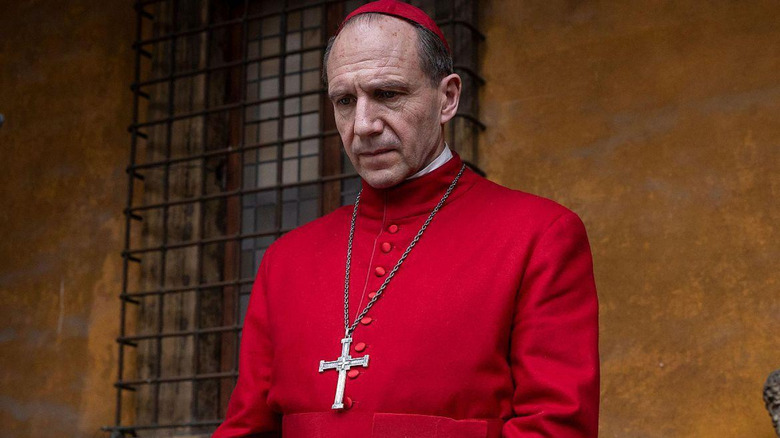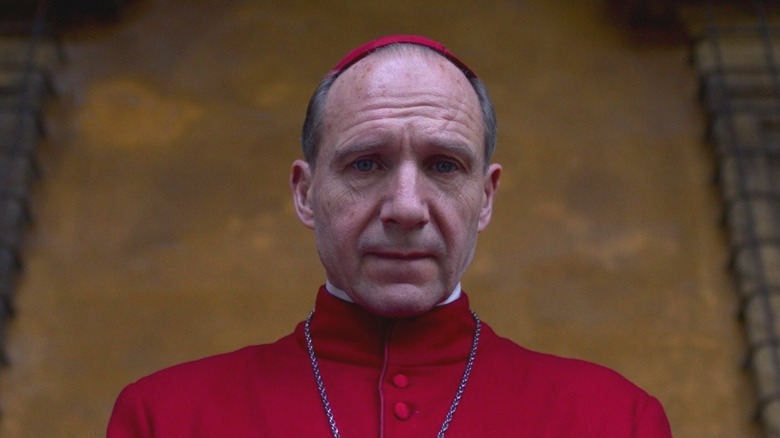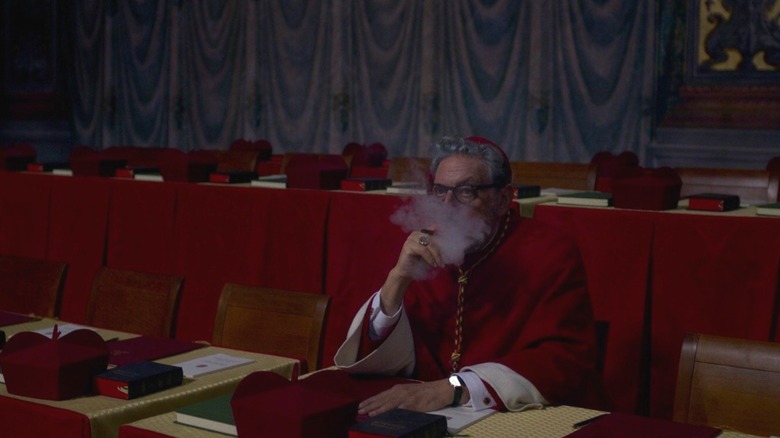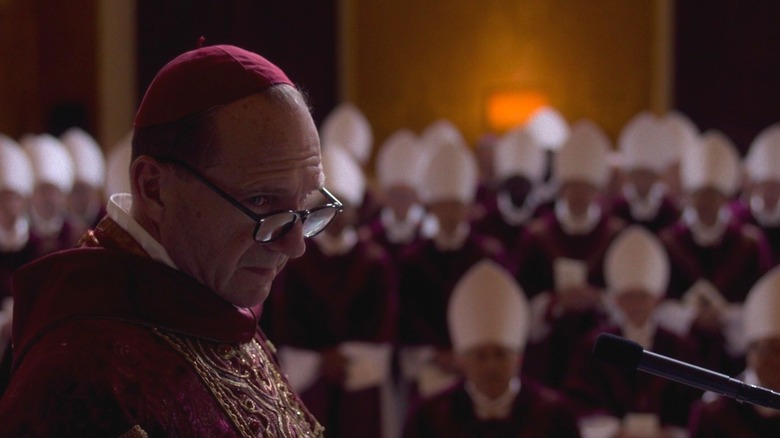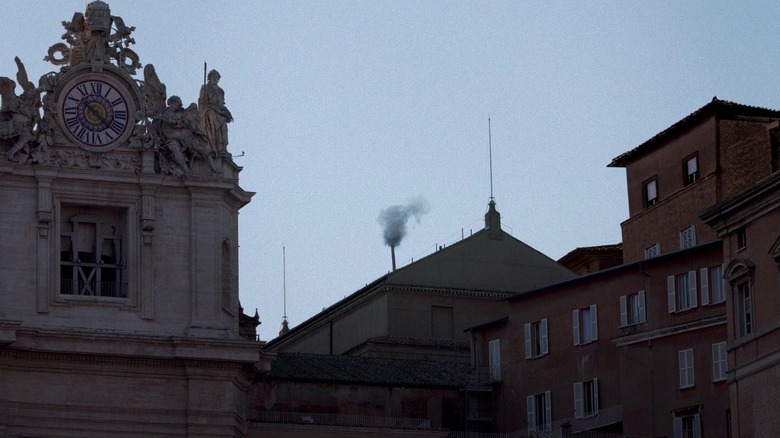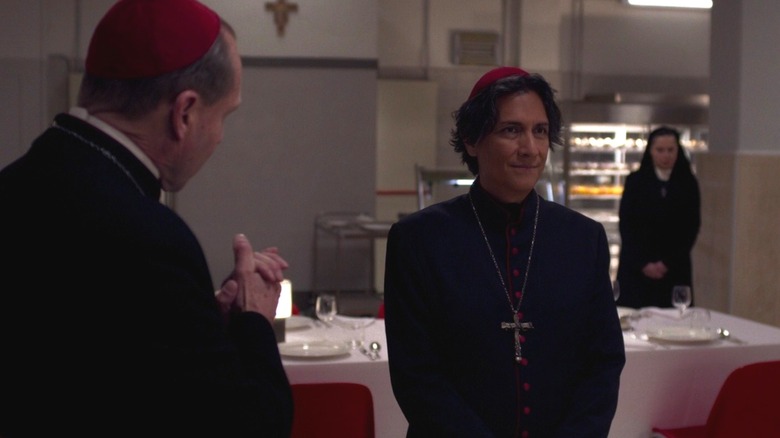Is Conclave Based On A True Story? What The Movie Gets Right About Choosing A New Pope
Following the death of Pope Francis on Easter Monday at the age of 88, people around the world have found new interest in the 2024 Edward Berger film "Conclave," which tells a fictionalized version of the choosing of the new leader of the Catholic church. "Conclave" is sumptuously shot and features an incredible cast, including Ralph Fiennes, Isabella Rossellini, Stanley Tucci, and John Lithgow, all performing at the top of their game, but with the real-world recent events in Rome leading us toward a conclave of our own, audiences have to wonder — just how accurate is "Conclave," really?
Well, it's complicated. The film strove for accuracy with regards to the costumes, location, and ceremony of the conclave, even though the process has been shrouded in secrecy for hundreds of years. Interviews with Catholic officials and scholars have revealed that while certain elements of the story are unrealistic, overall "Conclave" is an incredible peek into the mysterious world of the Vatican and the selection of a new Pope.
Conclave is based on the 2016 novel by Robert Harris
"Conclave," which won Best Adapted Screenplay at the 2025 Academy Awards for its screenplay by Peter Straughan, was based on the 2016 novel of the same name by well-known historical fiction author Robert Harris. Harris began his career in non-fiction and journalism before turning to historical thrillers, making an effort to retain some historical accuracy while also telling a twisting mystery. For "Conclave," Harris worked directly with the late English cardinal Cormac Murphy O'Connor, who took part in the 2005 and 2013 conclaves for Popes Benedict and Francis, which is a pretty great insight into how it all works.
Straughan and the filmmakers were also given a tour of the Sistine Chapel, where the conclaves are held, to help them in recreating the sacred chamber for the movie's sets and to give Straughan a sense of the room when writing. Straughan's Oscar win was well-deserved, as he took Harris' compelling church thriller and adapted it for the screen without trying to change too much. The book's Cardinal Lomeli becomes Cardinal Lawrence, to accommodate the casting of the truly terrific Ralph Fiennes, but otherwise, it's a pretty direct adaptation. Not only that, but Straughan has plenty of experience bringing historically-influenced stories to life, having written screenplays for "Tinker Tailor Soldier Spy" and "The Men Who Stare at Goats."
Conclave's political strife mirrors the church's divided reality
In "Conclave," Cardinal Lawrence is put in charge of leading the conclave, in which the cardinals (the highest-ranking officials in the clergy besides the Holy Father, the Pope) convene in seclusion to choose a new leader. There are serious political divides in the film, as some of the cardinals have very conservative ideas about how the church should be run, while others wish to continue in the late pope's legacy and grow more progressive with the times. It feels especially relevant given Pope Francis' humanist approach, leaving everyone to wonder if conservative cardinals will try to take things back to a less enlightened time.
While some critics of the film have said that it secularizes the church too much, imprinting American politics onto a Catholic frame, the divisive reaction to the film among Catholics points to art mirroring reality a bit more than folks might be comfortable with. For example, conservative bishop Robert Barron told his followers on social media to avoid the film because of its "woke" messaging of "diversity, inclusion" (pretty sure Jesus would have some thoughts about that), while Catholic film critic Zachary Lee praised it fervently, saying that it "makes a compelling and ecclesial call for a renewed spiritual stewardship characterized by humility, meekness and, curiously, doubt." The real-life cardinals in contention to possibly be the next pope are just as ideologically varied as the ones in "Conclave," which could make this particular conclave especially challenging.
Many of the rituals surrounding the conclave are accurate
People are always going to argue about theology and politics, but what about the more concrete elements of "Conclave"? According to researchers at CNN, many of the rituals large and small surrounding the conclave were accurate, from the arriving cardinals gathering outside for a quick smoke to the complex rules surrounding the voting process for the pope, conducted in the Sistine Chapel. The locations are all impeccably recreated, from the Sistine Chapel with Michelangelo's stunning artwork on its ceiling to the special guesthouse, the Domus Sanctae Marthae, where the cardinals stay during the conclave, served by a team of nuns.
Also accurate are the sealing of the deceased pope's room after his body's removal, checking throughout the Sistine Chapel for listening devices, the careful sequestering of the cardinals, the Latin oaths sworn by the cardinals before each vote, and the use of different chemicals to change the color of the smoke that rises from the burned vote cards: black for no decision and white to show that a new pope has been elected. There were some discrepancies with how certain tables are arranged and some minor issues with things like the frequency of the smoke, though that likely had to do with simplifying the storytelling.
Some little details were fudged a bit
Most of the voting in "Conclave" is accurate, as everyone involved must continue to vote until they reach a 2/3rds majority, writing their choices on paper ballots and swearing before God. One differing detail is that there are actually two votes per day, not just one, and each vote is burned, leading to smoke billowing out twice each day instead of the once as depicted in the film. (Honestly it makes sense to streamline it to one vote per day, for storytelling purposes.)
The other minor inaccuracy that's been called out by Vatican experts has to do with the deceased pope's signet ring, the Ring of the Fisherman. In the movie it is carefully removed from the pope's hand before he is taken to lie in state, but it is then privately destroyed. In real life, there's a special ceremony around the destruction of the previous pope's ring, to ensure that there are no official statements from "the Pope" that can happen after his death and before the rise of the new pope. Again, this was probably a matter of streamlining the story, though it would have been interesting to see the mysterious ceremony onscreen.
Cardinal Benitez causes the film's largest inaccuracy
The biggest inaccuracy in "Conclave" comes from the inclusion of Cardinal Benitez (Carlos Diehz), who had been serving as the archbishop of Kabul, Afghanistan and is admitted to the conclave despite having been confirmed in secret (in pectore). According to Reverend Thomas Reese, a senior analyst with the Religion News Service, "The biggest mistake in the movie was the admission of a cardinal in pectore into the conclave. If the name is not announced publicly by the pope in the presence of the College of Cardinals, he has no right to attend a conclave." That means it would be impossible for Cardinal Benitez to participate in the conclave at all, instead of almost immediately being accepted as happens in the movie.
And what about the film's final twist and the ultimate choice for this conclave's new pope? That has Catholics just as divided as the rest of the movie, so "accuracy" is in the eye of the beholder.
